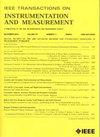A High-Sensitivity Microwave Resonator for Triclosan and Glyphosate Detection in Water
IF 5.6
2区 工程技术
Q1 ENGINEERING, ELECTRICAL & ELECTRONIC
IEEE Transactions on Instrumentation and Measurement
Pub Date : 2025-06-23
DOI:10.1109/TIM.2025.3581626
引用次数: 0
Abstract
This work presents the design, fabrication, and testing of a circular split ring resonator (Cir-SRR) with an embedded interdigital capacitor (IDC) for emerging contaminant (EC) detection. The IDC attached to the outer ring gap of the Cir-SRR concentrates the electric field and improves the sensitivity of the resonator. According to measurements, the IDC/Cir-SRR resonates at 1.77 GHz and achieves a quality factor Q of 295. The simulation reported a hot spot of 115.9204 dBV/m in the IDC detection zone. The resonant frequency shifts approximately 400 MHz when the liquid sample changes from water to ethanol. The sensitivity was studied using ethanol in deionized (DI) water. An average sensitivity of 1.53% was achieved in the relative permittivity range of 18–79. Triclosan and glyphosate were selected as ECs and were tested by dissolving them in a 50% ethanol-water mixture and water, respectively. Linear relationships between the用于水中三氯生和草甘膦检测的高灵敏度微波谐振器
本工作介绍了一种带有嵌入式数字间电容(IDC)的圆形分环谐振器(cirr - srr)的设计、制造和测试,用于新兴污染物(EC)检测。附着在cirr - srr外环间隙上的IDC使谐振腔的电场集中,提高了谐振腔的灵敏度。根据测量,IDC/ cirr - srr谐振频率为1.77 GHz,质量因子Q为295。仿真结果显示,IDC检测区存在115.9204 dBV/m的热点。当液体样品由水变为乙醇时,谐振频率漂移约400mhz。用乙醇对去离子水进行敏感性研究。在相对介电常数18 ~ 79范围内,平均灵敏度为1.53%。选择三氯生和草甘膦作为ECs,分别溶解于50%乙醇-水混合物和水中进行测试。三氯生和草甘膦的$S_{\mathbf{21}}$传输参数与浓度分别在0 ~ 50和0 ~ 35 $\mu $ g/mL范围内呈线性关系。草甘膦溶液的灵敏度为$6.87\ × 10^{-2}$ dB/($\mu $ g/mL),检出限(LOD)为$1.83~ $ mu $ g/mL。相比之下,三氯生溶液的值为$1.47\乘以10^{-2}$ dB/($\mu $ g/mL)和1.18 $\mu $ g/mL。结果表明,该技术为快速检测新出现的水污染物提供了一种可行的方法。
本文章由计算机程序翻译,如有差异,请以英文原文为准。
求助全文
约1分钟内获得全文
求助全文
来源期刊

IEEE Transactions on Instrumentation and Measurement
工程技术-工程:电子与电气
CiteScore
9.00
自引率
23.20%
发文量
1294
审稿时长
3.9 months
期刊介绍:
Papers are sought that address innovative solutions to the development and use of electrical and electronic instruments and equipment to measure, monitor and/or record physical phenomena for the purpose of advancing measurement science, methods, functionality and applications. The scope of these papers may encompass: (1) theory, methodology, and practice of measurement; (2) design, development and evaluation of instrumentation and measurement systems and components used in generating, acquiring, conditioning and processing signals; (3) analysis, representation, display, and preservation of the information obtained from a set of measurements; and (4) scientific and technical support to establishment and maintenance of technical standards in the field of Instrumentation and Measurement.
 求助内容:
求助内容: 应助结果提醒方式:
应助结果提醒方式:


